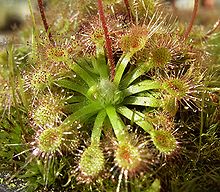Drosera mannii
| Drosera mannii | ||||||||||||
|---|---|---|---|---|---|---|---|---|---|---|---|---|

Drosera mannii , flower |
||||||||||||
| Systematics | ||||||||||||
|
||||||||||||
| Scientific name | ||||||||||||
| Drosera mannii | ||||||||||||
| NGMarchant & Lowrie |
Drosera mannii is a carnivorous plant from the genus sundew ( Drosera ). It belongs to the group of so-called dwarf sundews and is native to southwestern Australia.
description
Drosera mannii is a perennial herbaceous plant . This forms a flat, compact, rosette-shaped bud from horizontal leaves with a diameter of about 1.5 cm. The stem axis is short and covered with few or no withered leaves from the preseason.
The bud of the stipules is broadly ovate, 3 mm long and 3 mm in diameter at the base. The stipules themselves are 3.5 mm long, 3 mm wide and three-lobed. The middle lobe is divided into 3 segments.
The leaf blades are broadly elliptical, 2.5 mm long and 2 mm wide. The longer tentacle glands are on the edge, the shorter ones on the inside. There are some glands on the underside. The leaf stalks are up to 5 mm long, 0.5 mm at the base, expand to 1 mm in the middle and taper to 0.7 mm at the leaf blade. They are half lanceolate and completely hairless.
Flowering time is November to December. The one or two flower stalks are 5 to 10 cm long and hairless below the inflorescence, covered with glands above. The inflorescence is a coil of 10 to 24 flowers on approximately 2.5 mm long pedicels. The broad, lance-shaped sepals are 2.5 mm long and 1.3 to 1.5 mm wide. The edges and tips are serrated and free of glands. The remaining surface is covered with cylindrical, red-headed glands. The light pink to white petals are wedge-shaped, 5 to 8 mm long and 5.5 mm wide. The base of the petals forms a wedge-shaped, greenish finger 1 mm long and 0.3 mm wide.
The five stamens are 2.5 mm long. The threads are white, the anthers are yellow with red spots, and the pollen are yellow. The pale green ovary is shell-shaped, 1.3 mm long and 1.5 mm in diameter. The 5 white, horizontally stretched styluses are 2.5 mm long and 0.1 mm in diameter. The scars are white, inverted pear-shaped, 1 mm long, 0.5 mm wide at the base, and taper evenly to the tip.
The formation of brood scales is typical of dwarf sundews : The lance-shaped, 0.7 mm thick brood scales are formed in large numbers from late November to early December and are approx. 0.9 mm long and 0.4 mm wide.
The number of chromosomes is 2n = 14.
Distribution, habitat and status
Drosera mannii occurs only on a small area in the extreme southwest of Australia. The plant thrives there on clay soils in damp watersheds. The plant was also found on peaty sand with similar moisture conditions. The only known population is at Bannister .
Systematics
Drosera mannii was named after the Australian carnivore lover Phil Mann.
literature
- Allen Lowrie: Carnivorous Plants of Australia. Volume 2. University of Western Australia Press, Nedlands 1989, ISBN 0-85564-300-5 , p. 78.
Individual evidence
- ^ Drosera mannii at Tropicos.org. In: IPCN Chromosome Reports . Missouri Botanical Garden, St. Louis

